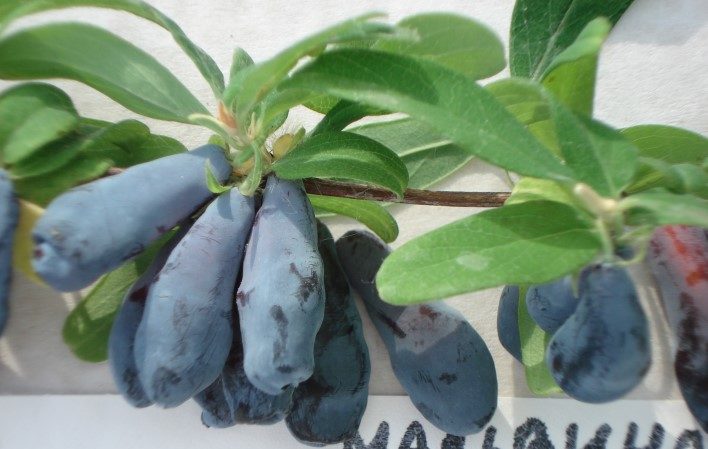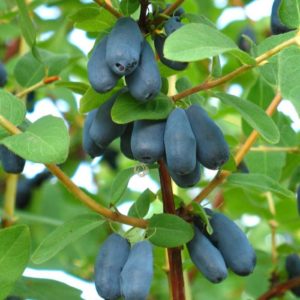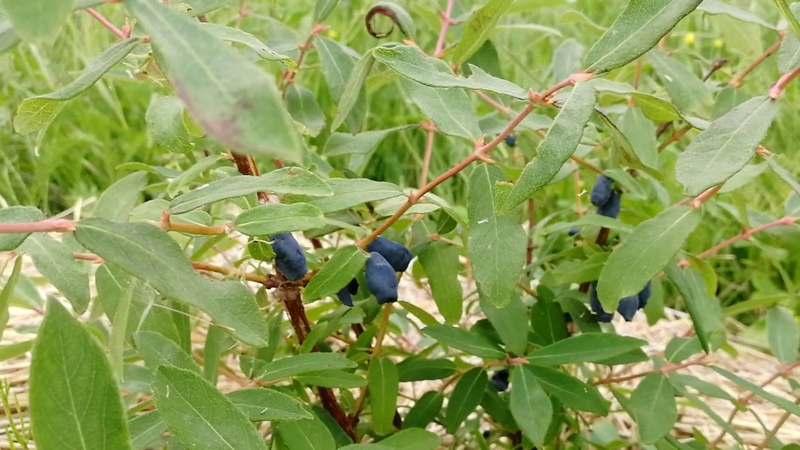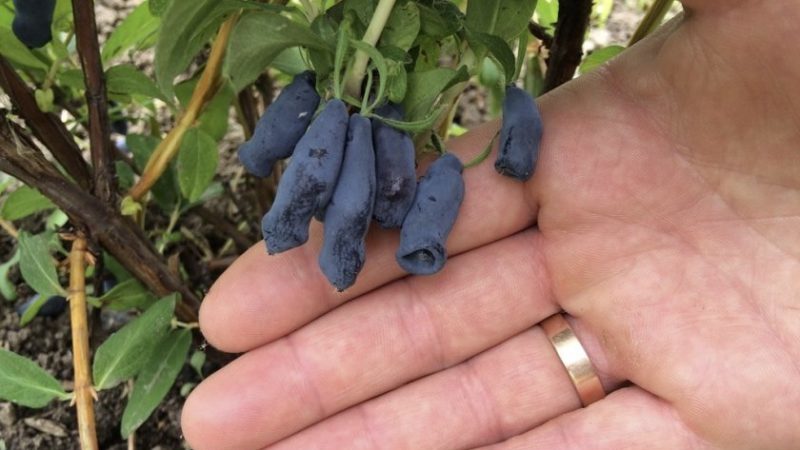Productivity variety of honeysuckle "Malvina" with sweet and sour berries without bitterness
Edible varieties of honeysuckle displace decorative varieties from summer cottages, since they are practically not inferior to them in their ability to decorate the garden and at the same time delight with a harvest of delicious berries. In this article, we will tell you in detail about the Malvina variety, the fruits of which are characterized by universal use, dessert taste and rich chemical composition.
The content of the article
Description of the variety of honeysuckle Malvina
Malvina is a medium-ripening edible honeysuckle variety. In central Russia, the crop is harvested in late June - early July. Average yield - up to 3.2 kg per bush or 48.9 kg / ha.
In a refrigerator berries retain their qualities for 3 weeks, in case of overripe - 3-4 days.

History of origin and distribution
Malvina's honeysuckle was bred in St.Petersburg by breeders of the Pavlovsk experimental station of the V. NI Vavilov on the basis of a plant of elite form No. 21-5 from the Primorsky Territory and the Leningradsky Giant variety. The authors of Malvina are M.N. Plekhanov and A.V. Kondrikov.
The variety is included in the State Register of Breeding Achievements of Russia in 2002 with a recommendation for cultivation in all regions.
Characteristics and description of the bushes
This honeysuckle is a medium-sized (about 1.5 m high) bushes with a squat oval crown, dark brown skeletal branches and thin, straight, pubescent shoots of light green color.
The leaves are large, 6 cm long and 3 cm wide, dense, elongated-oval with a slightly pointed tip, dark green, have barely noticeable pubescence.
During the flowering period, which occurs in early May, small bell-shaped, pale yellow flowers, collected in racemose inflorescences, appear at the nodes along the length of the shoots.
Resistant to temperatures
Malvina is a frost-resistant variety. The bushes can withstand a drop in air temperature to -50 ° C, provided that the aboveground part is covered with agrofibre. The root system does not freeze at –40 ° C, flower buds survive return frosts down to –8 ° C, but die if the temperature drops further.
Honeysuckle can tolerate heat, but only with regular watering.
Moisture and drought resistance
The variety cannot be called drought-resistant. Lack of moisture leads to a decrease in yields, crushing of berries and a deterioration in their taste.
Disease and pest resistance
Malvina's honeysuckle is resistant to most common diseases and pests. However, in adverse weather conditions, it can be affected by aphids, whiteflies, scale insects, spider mites, powdery mildew, black fungus, tuberculariosis and rust.
Characteristics and description of fruits
The berries are large - they reach 2.9 cm in length, 1.2 cm in diameter and weigh on average 1-1.1 g. They have an elongated pear-shaped shape, covered with a dense, bluish-blue skin without pubescence with an intense bluish waxy bloom ...
Fibrous pulp, sweet and sour dessert taste, without bitterness.
The fruits contain 8% sugars, 1.9% organic acids, 52 mg of ascorbic acid (per 100 g), 14.6% of dry matter.
Areas of use
Malvina berries are consumed fresh, frozen or dried.They are also suitable for making preserves, jellies, jams, juices, stewed fruit, jelly and even homemade wine.
Advantages and disadvantages of the variety
Variety advantages:
- resistance to frost, diseases and pests characteristic of the culture;
- suitable for production cultivation technology;
- large-fruited;
- weak crumbling of berries;
- good transportability and long lasting shelf life;
- excellent taste and rich chemical composition of the fruit;
- relatively early ripening;
- good yield.
Malvina has no serious flaws. The insignificant disadvantages include only exactingness to watering and difficult collection, since the berries are poorly separated from the stalks.
Growing technology
The success of growing Malvina depends primarily on how correctly the seedlings are prepared and the place and landing dates.
For planting in open ground, two-year-old seedlings 40 cm high with 2-3 aerial branches and a developed root system are chosen. It is important that the shoots are resilient and have large, lively buds.
Reference. Before planting, the roots of the seedlings are kept in a solution of a growth stimulant ("Kornevin", "Heteroauxin") for an hour. This improves the survival rate of the planting material.
Optimal conditions

Plants are planted in a lighted place protected from gusty winds and drafts. Lack of light and shading negatively affect the fruiting of the bushes.
Malvina prefers a moderately moist, nutritious soil with a medium to neutral acidity level. The best option is loamy soil. In an acidic environment, the bushes develop poorly, wither, the leaves become pale.
When choosing a site for planting, pits and places where groundwater is located close to the soil surface are avoided - stagnant moisture leads to rotting of the root system.
Terms and rules of landing
The optimal time for planting Malvina is from August to November. Spring planting is not recommended due to early vegetation. It is permissible to plant plants in the spring only in the southern regions by transshipment.
Landing rules:
- 10-15 days before planting the seedlings, dig up the plot and clear it of plant debris and weeds.
- Dig out the 40x40x40 cm landing grooves.
- Fill a layer of drainage from expanded clay, pebbles or broken bricks to the bottom, on top - a nutritious soil mixture (excavated soil, 2 buckets of humus, 2 tbsp. L. Superphosphate and 0.5 kg of wood ash).
- In the center of the planting pit, form an earthen hill, place a seedling on it and spread its roots over the surface of the embankment.
- Cover the rhizome with earth so that it is evenly distributed between the individual roots, and the root collar deepens by a maximum of 3 cm.
- Tamp the soil in the near-stem zone, water the seedling abundantly.
- Cover the surface with peat, sawdust or bark.
The distance between the bushes should be 2 m, between the rows - 2.5 m.
Further care
Young bushes are watered 2-3 times a month, adults - 5-6 times a season with settled water heated in the sun. The approximate water consumption is 15 liters per plant. If during the pouring of the fruits it is hot, dry weather, the water consumption is increased to 3 buckets per bush. Water is introduced into the irrigation furrows around the bush and from a hose with a spray.
Important! Do not use the sprinkling method during flowering due to the risk of washing off pollen from the flowers.
To retain moisture in the soil and stop the growth of weeds, the soil is mulched with hay, straw or compost.
In the third year, the plants begin to be fed with organic fertilizers according to the scheme:
- after melting snow - 10 kg of humus per bush;
- during budding and ovary formation - ash solution (1 liter of ash per 10 liters of water);
- late autumn - a mixture of 5 kg of compost, 100 g of ash and 40 g of superphosphate per 1 m².
Once every 3 years in the fall, honeysuckle is fed with potash fertilizers at the rate of 15 g per 1 m². This increases the resistance of the bushes to diseases.
When the plants reach the age of three, they begin prune... Every year in early spring or late autumn, all diseased, broken, dry and improperly growing branches are removed from the bushes. Places of cuts, especially large ones, are treated with garden pitch.
Possible problems, diseases, pests

Diseases and pests threatening Malvin's honeysuckle:
| Pest / disease | Signs and symptoms | Treatment |
| Aphid | The insect sucks the juices from the leaves and shoots, which makes the bushes weaken, wither, and lose resistance to viruses. | The bushes are sprayed with insecticidal preparations - "Inta-Vir", "Fitoverm", "Aktellik". You can stimulate the defenses of plants by spraying the crown with "Epin" or "Zircon". |
| Whitefly | Leaves curl and deform, turn yellow, become stained. | |
| Shield | The bushes gradually dry up and die. | |
| Spider mite | A thin white web appears on the leaves and shoots. | |
| Powdery mildew | A powdery coating of grayish-white color is visible on the leaves. | Treatment of bushes with systemic fungicides: "Topaz", "Skor", "Alto", "Folikur". |
| Rust | Yellow spots appear on the leaf plates, which eventually grow over the surface of the bush. | |
| Tuberculariosis | The leaves wither, the shoots dry out, and red swells appear on them. | The affected parts of the plant are cut off. At the beginning of the growing season and after flowering, the bushes are sprayed with "Fitolavin" and "HOM". |
| Sooty mushroom | The fungus develops on the secretions of aphids. A dark bloom appears on the leaves. | In the phase of the green cone, the mixture is treated with Bordeaux mixture and Fundazol. The procedure is repeated after 7 days. |
Chemical treatment of bushes is permissible only before the appearance of ovaries or after harvesting.
Wintering
Malvina bushes do not need in a winter shelter. The only exceptions are extremely low temperatures (about –50 ° C). In this case, the plants are covered with agrofibre.
Otherwise, Malvina's preparation for winter consists of abundant (at least 30 liters for each bush) watering 15 days before the expected frost and mulching the near-stem zone with compost.
Reference. In case of slight freezing, the tops of young shoots in the spring are cut to healthy tissues.
Reproduction
Since the seed method is laborious and most often ends in failure, Malvina is propagated by green cuttings, layering and dividing the bush.
After flowering, cuttings with a maximum length of 12 cm are cut from young shoots, which are placed in a fertile substrate, watered, create greenhouse conditions for them and kept at a temperature of + 25 ° C, ventilating and moisturizing daily. Planting material is obtained in the fall; it is planted in open ground in the second decade of October.
Reproduction by layering is the easiest way. To do this, at the end of June, the top of the shoot is bent to the ground, covered with a layer of soil 5 cm thick, fixed with a metal clip and watered abundantly all summer. In the fall, when its own roots appear on the shoot, it is separated from the mother bush and planted on the site.
When dividing a bush, the plant is dug up, divided into several parts so that each has its own root system, and planted as independent plants.
Features of growing varieties depending on the region

The agrotechnical requirements of Malvina's honeysuckle do not depend on the region of its cultivation.
Only the possible need for insulation and shelter in the northern regions, where the winters are harsh, should be taken into account, as well as the need for more frequent and abundant watering in the southern regions with an arid climate.
Pollinating varieties
Malvina's honeysuckle is a self-fertile and cross-pollinated variety, therefore it needs pollinating varieties. Most suitable options:
- Blue spindle;
- Blue bird;
- Moraine;
- Start;
- In memory of Kuminov;
- Kamchadalka.
Conclusion
Malvina is a high-yielding variety of edible honeysuckle, which is characterized by frost resistance, unpretentiousness, large-fruited and relatively early ripening. Malvina does not have special requirements for the soil composition and climatic conditions, therefore it is successfully cultivated in all regions.